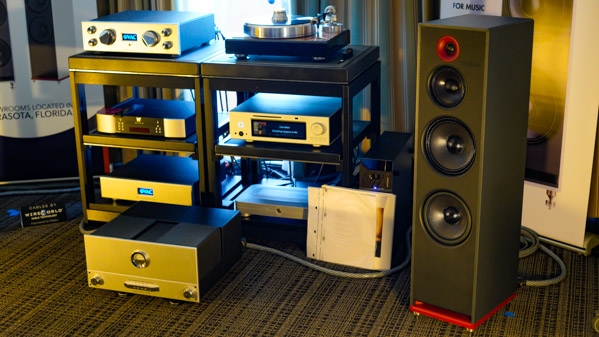| Columns Retired Columns & Blogs |
Stenheim Alumine 3 are in the same price range as Wilson Sasha DAW and Vimberg Mino :-) ........

The version being demoed here at the Florida Audio Expo—by Panchard, one of many designers and company chiefs at this small show—are the final production versions.
Take this with a grain of salt: Even I don't consider a comparison based on listening sessions 10 months apart in different rooms with different music and systems to be totally valid. And yet: As soon as I walked into the Stenheim room here at the Florida Audio Expo, I knew these Alumine 3s sounded different from the ones I'd heard at AXPONA. Different and better.
I think it was John DeVore who once told me: If you perceive a problem with the highs, look to the lows, and vice versa. The difference I perceived with the Alumine 3 was in the treble, but the post-AXPONA alterations are in the bass.
Panchard described the Alumine 3 as a 3.5-way: It's a laminar-flow-ported aluminum box stuffed with a dome tweeter, a 5 1/4" midrange driver, and two 8" woofers. The lower of the two woofers, which is rolled off around 100Hz, has a rubber surround, while the upper woofer, which extends up into the midrange, now has a fabric surround; the absence of rubber's restoring force makes the driver faster. (Below 100Hz, the output of the two woofers is the same.)
The Alumine 3 should be very easy to drive, with a claimed sensitivity of 93dB and a minimum impedance of 5 ohms. It presents an amplifier with a nominal 8 ohm load.
With this version of the Alumine Three, there was no edge to the highs. Highs, lows, and midrange were in balance, with perhaps a little more treble energy than I'm used to, but that may have come from elsewhere in the system (i.e., the phono cartridge), and anyway it's not a complaint. Imaging was superb; on "Malletoba Spank" and "Red Garter"—the first two tracks on the reissue of Duke Ellington's Jazz Party in Stereo, there was a good-sized stage in this small room (which limited speaker separation to just a few feet apart), and Jimmy Woode's bass was out on the balcony, some 10' back from the plane of the speakers. On the second track, the ride cymbal came from directly behind the right speaker—an odd sensation.
The system also encompassed a VAC Master Line Stage ($28,000) and Signature 200iQ Stereo Amplifier ($14,500); Acoustic Signature XX turntable ($5000), TA-2000 tonearm ($2995), and TANGO Reference phonostage ($5000); Dynavector XX2 MC phono cartridge ($2000); Critical Mass Systems Sotto Voce rack with three shelves; and cabling by Wireworld and Audioquest.

Stenheim Alumine 3 are in the same price range as Wilson Sasha DAW and Vimberg Mino :-) ........

... the following test report would suggest that the Dynavector XX2 phono cartridge was unlikely to be responsible for any observed excess of treble energy in this system.
https://www.dynavector.com/pdf/xx2mk2_hificritic.pdf

My impression of the 3 as well at Axpona. However, the Stenheim book shelf speaker in the adjacent room was, I thought, incredible. Even sitting within a few feet of the speakers, I was floored at the sound that seemed so detached from the speakers. Probably my #2 speaker from Axpona.